Famous Oil Paintings – The Top Oil Artworks Ever Made
The majority of the world’s most famous paintings have been executed in oil, which is a defining medium that every artist has tried their hand at. The history of oil painting goes back to the 7th century and has since been adapted and processed to provide some of the most captivating colors available to artists. In this article, we will explore the history of oil painting as well as the top 15 most famous oil paintings of all time! Read on to find out how oil painting as a medium has been used to produce such fine works of art that are celebrated across the world.
Contents
- 1 The History of Oil Painting
- 2 Top 15 Most Famous Oil Paintings of All Time
- 2.1 Arnolfini Portrait (1434) by Jan van Eyck
- 2.2 Lady with an Ermine (1489) by Leonardo da Vinci
- 2.3 Mona Lisa (1503) by Leonardo da Vinci
- 2.4 The Storm on the Sea of Galilee (1633) by Rembrandt Van Rijn
- 2.5 Las Meninas (1656) by Diego Velázquez
- 2.6 Girl with the Pearl Earring (1665) by Johannes Vermeer
- 2.7 Napoleon Crossing the Alps (1801 – 1805) by Jacques-Louis David
- 2.8 Whistler’s Mother (1871) by James Abbott McNeill Whistler
- 2.9 Impression, Sunrise (1872) by Claude Monet
- 2.10 The Starry Night (1889) by Vincent van Gogh
- 2.11 The Old Guitarist (1903 – 1904) by Pablo Picasso
- 2.12 The Kiss (1908 – 1909) by Gustav Klimt
- 2.13 American Gothic (1930) by Grant Wood
- 2.14 The Persistence of Memory (1931) by Salvador Dalí
- 2.15 Guernica (1937) by Pablo Picasso
- 3 Frequently Asked Questions
The History of Oil Painting
If you have ever attempted oil art then you might do well to mention that it is no easy medium, to begin with. For centuries, artists have produced oil artworks that produce a diverse array of visual forms and representations and thus highlight the dynamism of the medium and how it can be manipulated and controlled.
In 2008, it was discovered that the history of oil painting dates as far back as the 7th century and was attributed to an unknown artist who used oils that were extracted from poppies or walnuts to paint a cave complex in Bamiyan, Afghanistan. How fascinating, right?
When one thinks of cave paintings, one does not think of oil on a rock. So, what is oil paint? Oil paint is an artistic medium that consists of drying oils that hold different pigments in them. Oil art requires artists’ oil paint, which can be made by combining dry powder pigments with refined linseed oil to produce a stiff paste. This is then ground using friction from steel roller mills to achieve consistency in color. The standard texture of oil paint is compared to smooth butter without a rough texture and not too runny.

For artists to achieve a lighter or weaker quality, the oil paints can be mixed with liquid painting mediums such as turpentine. In Europe, the origins of oil painting occur around the 11th century and eventually in the 15th century, appeared through easel painting with various tempera painting techniques. By 1400, the development of oil paintings received a boost through the refinement of linseed oil and the increased availability of “volatile solvents”, which replaced the egg yolk-based tempera method and drew in the emerging art styles of the Renaissance.
Oil was first used alongside varnish as a glaze over tempera panels and then painted over in a linear drawing fashion.
The binders and colors found in the 7th-century cave painting in Bamiyan were studied by researchers using a wide variety of X-ray technologies and it was found that the early oil artwork was created by artists who traveled along the Silk Road trade route, which ran from China to the West. It has long been established that the birthplace of oil painting was Asia and not the common belief of the medium originating in Europe.
Top 15 Most Famous Oil Paintings of All Time
Out of the myriads of oil paintings and masters of the medium in art history, there are a select few that top the list of the world’s most famous oil paintings of all time. Below, we will discuss the top 15 most famous oil paintings of all time as well as what makes these works so popular.
Arnolfini Portrait (1434) by Jan van Eyck
| Artist | Jan van Eyck (1390 – 1441) |
| Date | 1434 |
| Medium | Oil on oak |
| Dimensions (cm) | 82 x 60 |
| Where It Is Housed | The National Gallery, London, England |
One cannot discuss oil painting without mentioning the name of one of the best oil artists, Jan van Eyck. Van Eyck was one of the first Early Netherlandish masters of oil painting who created one of the most famous oil painting portraits of all time, the Arnolfini Portrait. Created in 1434, this spectacular and highly symbolic portrait depicts the double full-length portraits of an Italian merchant by the name of Giovanni di Nicolao Arnolfini with his wife, presumably right after their marriage at their home in Bruges.
The painting contains many symbolic references that make the painting one of the most complex paintings in art history.
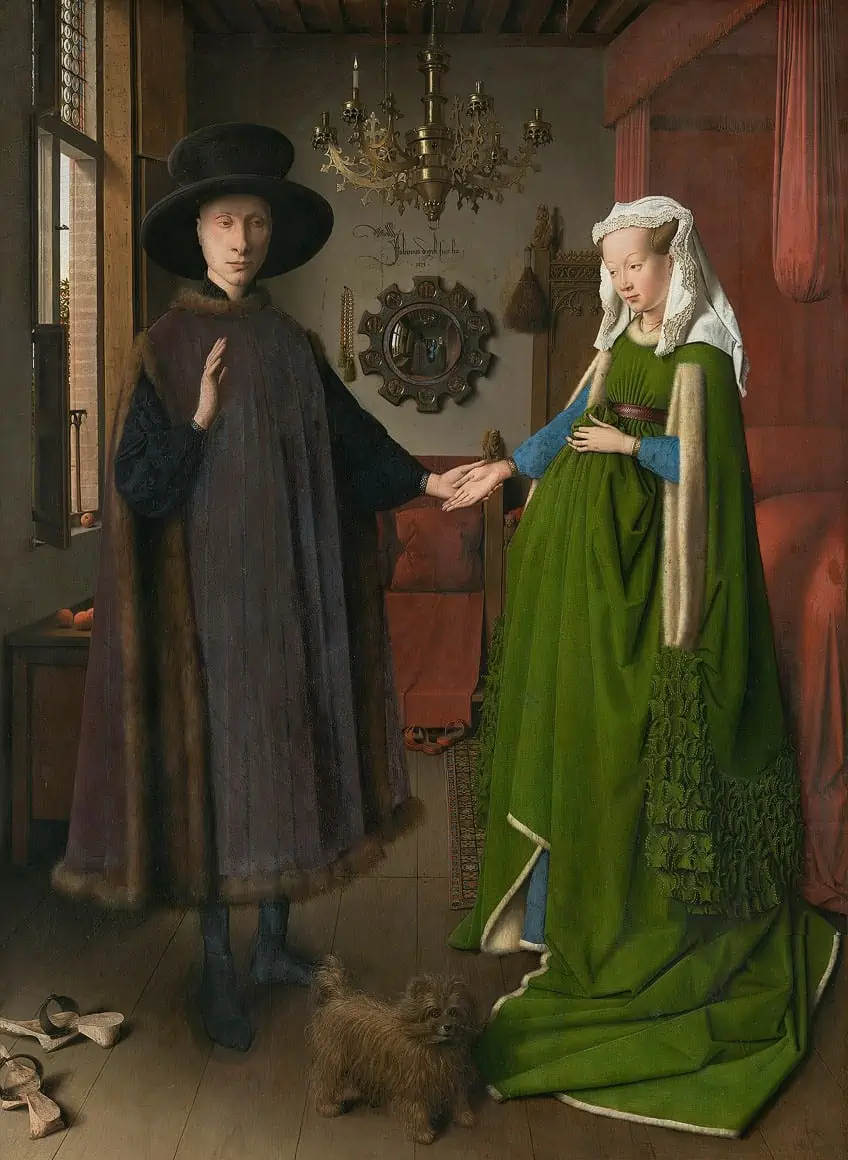
Van Eyck is praised for his depiction of space and geometric orthogonal perspective that documents the newlywed’s union. For this painting, Van Eyck selected an oil paint with a longer drying time and blended in the colors wet-on-wet in a technique known as alla prima. Van Eyck masterfully depicted the various surfaces and textures in the room with ease and even included a mirror in the image with his self-portrait in it. The illusionistic nature of the Arnolfini Portrait is worth appreciating for its time and is often referred to as the first genre painting.
The Arnolfini Portrait is estimated to be worth around $117.8 million.
Lady with an Ermine (1489) by Leonardo da Vinci
| Artist | Leonardo di ser Piero da Vinci (1452 – 1519) |
| Date | 1489 |
| Medium | Oil on wood panel |
| Dimensions (cm) | 54 x 39 |
| Where It Is Housed | The National Museum in Krakow, Krakow, Poland |
Leonardo da Vinci was known to be a genius who dabbled in multiple disciplines. Da Vinci’s contributions to the Western art historical canon are by far the most notable. His works can be found in many public and private collections around the world, including the British Royal family’s collection.
This famous oil portrait painting by Da Vinci is by far one of the most recognized oil portrait paintings in art history, next to the Mona Lisa (1503).
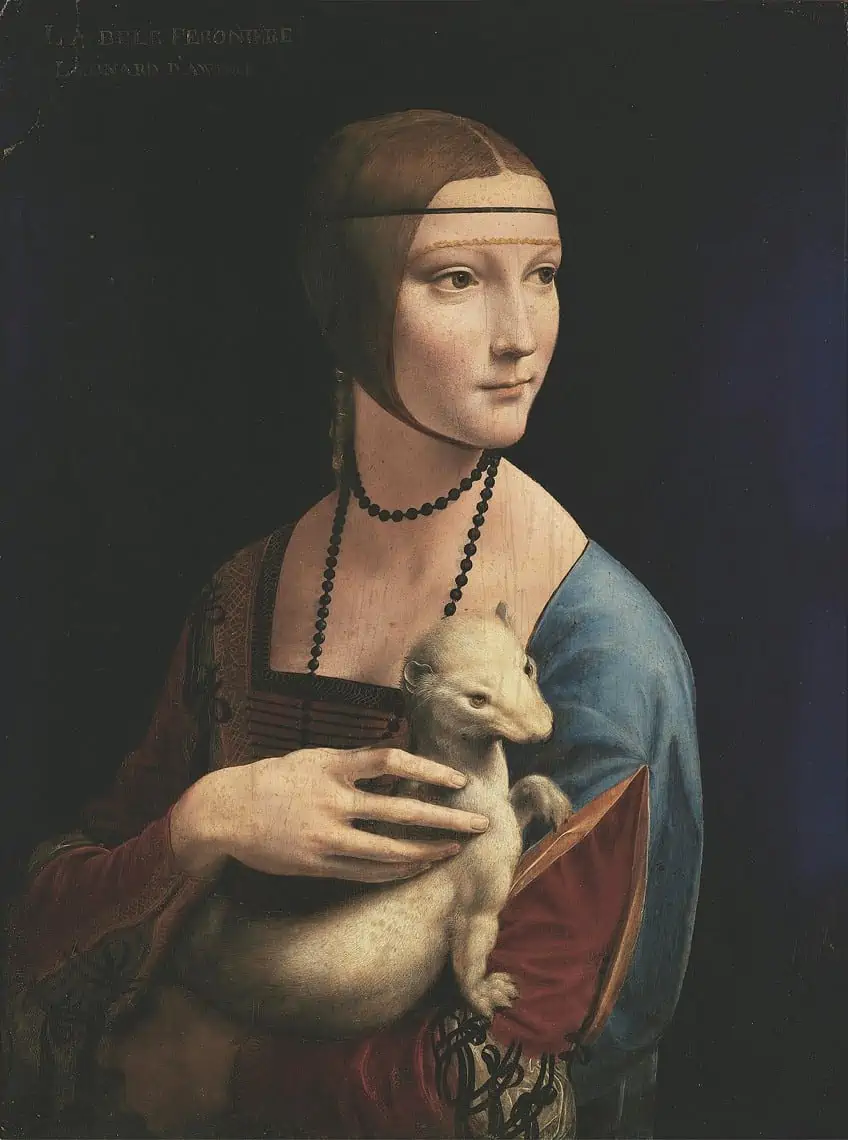
Lady With an Ermine was acquired by the son of Princess Izabela Czartoryska, Adam Jerzy, in 1800 and then donated to a museum in Pulawy. The sitter was formerly mistaken to be a mistress of King Francis I (France) but later on, it was discovered that the sitter was a woman named Cecilia Gallerani, who was a high-profile mistress of Lodovico Sforza, represented by the white ermine in the portrait. Da Vinci skillfully demonstrated his talent in lighting and three-dimensional painting techniques that highlight the Renaissance concept of “an image as an illusion of natural vitality.”.
The background of the image was repainted as black in the 19th century and it is believed that the original contained some lighting that made it seem as though Gallerani was emerging from the shadows.
Mona Lisa (1503) by Leonardo da Vinci
| Artist | Leonardo di ser Piero da Vinci (1452 – 1519) |
| Date | 1503 |
| Medium | Oil on poplar panel |
| Dimensions (cm) | 77 x 53 |
| Where It Is Housed | The Louvre Museum, Paris, France |
Out of the many famous oil paintings in the world, the Mona Lisa easily tops the list since it is the most visited artwork at the Louvre Museum. The Mona Lisa is a 16th-century oil-on-panel painting by none other than the polymath, Leonardo da Vinci who is commonly associated with the drawing, the Vitruvian Man (1490).
The Mona Lisa was first made famous for going missing at the Louvre back in 1911, which stirred the interest of global art communities.
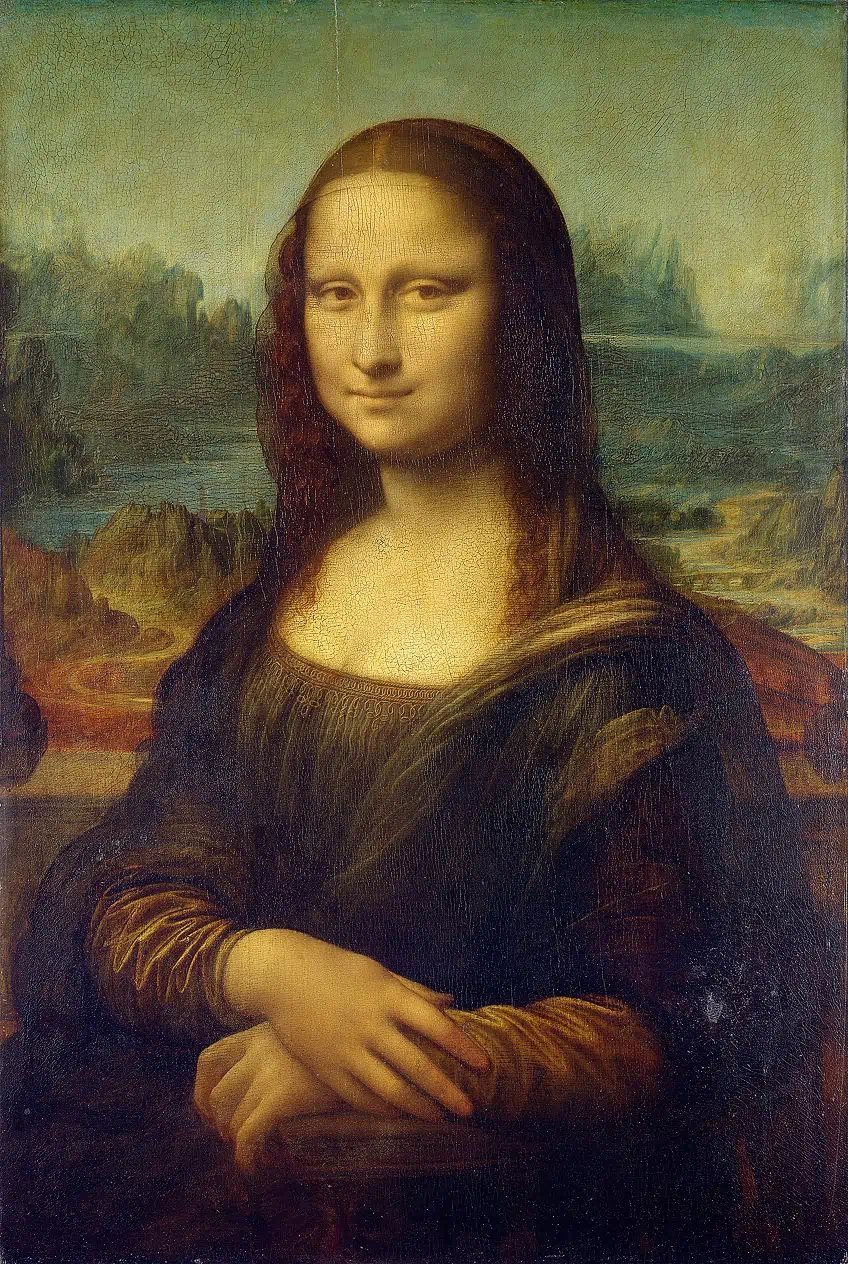
The oil painting was then recovered and returned to the Louvre Museum two years later after the thief attempted to sell the painting to an art dealer who knew better. Aside from its chaotic history, the Mona Lisa is also admired for its subject and technical execution by Da Vinci, which earned the painting its value as one of the most treasured oil paintings in history.
The model of the painting, Lisa Gherardini del Giocondo, was married to a wealthy silk trader and was also a mother of five.
The sitter had her legacy imprinted in the Mona Lisa and little did she know that her smile was to become the most recognized and admired in art history for the next few centuries. According to recent statistics, the Mona Lisa is currently valued at a whopping $860 million, which is an astronomical figure for an oil painting alone and is one of the most expensive oil-painted portraits to exist.
The Storm on the Sea of Galilee (1633) by Rembrandt Van Rijn
| Artist | Rembrandt Harmenszoon van Rijn (1606 – 1669) |
| Date | 1633 |
| Medium | Oil on canvas |
| Dimensions (cm) | 160 x 128 |
| Where It Is Housed | Missing; last housed at the Isabella Stewart Gardner Museum in the United States |
This classic Dutch Golden Age painting formed part of the selection of works stolen during the Isabella Stewart Gardner heist in 1990. The Storm on the Sea of Galilee portrays Christ’s disciples struggling to keep their stability on the fishing boat while a violent storm erupts around them. Christ is seen on the right of the painting, illustrated as the only person displaying a calm demeanor. The sail of the boat is ripped by a massive wave that knocks the boat about the stormy sea.
The composition of the painting was inspired by a print created by Adriaen Collaert and a design by Maerten de Vos.

Rembrandt’s painting follows a similar composition that portrays the boat tilting forwards and the majority of the space is occupied by the main motif, as seen with the disciples fighting the elements. Rembrandt is considered one of the greatest oil painters in history and was most famous for his self-portraits, genre paintings, biblical paintings, and landscapes.
Rembrandt also operated during the Dutch Golden Age, which is considered one of the richest eras in art history since it birthed important art styles such as the Baroque art style.
As seen in images of The Storm on the Sea of Galilee, Rembrandt was a remarkable painter whose skill in religious scenes goes almost unmatched. Aside from painting, Rembrandt also made significant contributions to the world of printmaking and was dubbed the best etcher during his lifetime.
Las Meninas (1656) by Diego Velázquez
| Artist | Diego Rodríguez de Silva y Velázquez (1599 – 1660) |
| Date | 1656 |
| Medium | Oil on canvas |
| Dimensions (cm) | 318 x 276 |
| Where It Is Housed | Museo Nacional del Prado, Madrid, Spain |
Las Meninas is one of the most famous oil paintings by Spanish painter Diego Velázquez who was one of the best painters under the court of King Philip IV of Portugal and Spain. Another pioneer of Baroque art during the Spanish Golden Age, Velázquez was tasked with painting the Ladies in Waiting, featuring Philip’s daughter, Infanta Margaret Theresa, and her entourage. Velázquez had already been serving under the king for 30 years when he was commissioned for this painting and was already an established and indispensable member of the court.
The painting was commissioned by Philip for hanging in his summer palace office and remained there until 1819, after which it was moved to the Prado Museum.

Girl with the Pearl Earring (1665) by Johannes Vermeer
| Artist | Johannes Vermeer (1632 – 1675) |
| Date | 1665 |
| Medium | Oil on canvas |
| Dimensions (cm) | 44 x 39 |
| Where It Is Housed | Mauritshuis, The Hague, Netherlands |
Girl With a Pearl Earring is one of the most endearing oil paintings from the Dutch Golden Age, created in 1665 by Johannes Vermeer. While Vermeer’s portfolio is not a very large one, his technique and application of the medium are one to imitate. The painting’s sitter is an imagined young woman who glances over her shoulder while staring at the viewer.
The highlight of the painting is not only her delicate pearl earring, which steals the show in all its glamor but the fact that Vermeer created a very intimate moment between the imaginary woman and the viewer as if the viewer knew her personally.
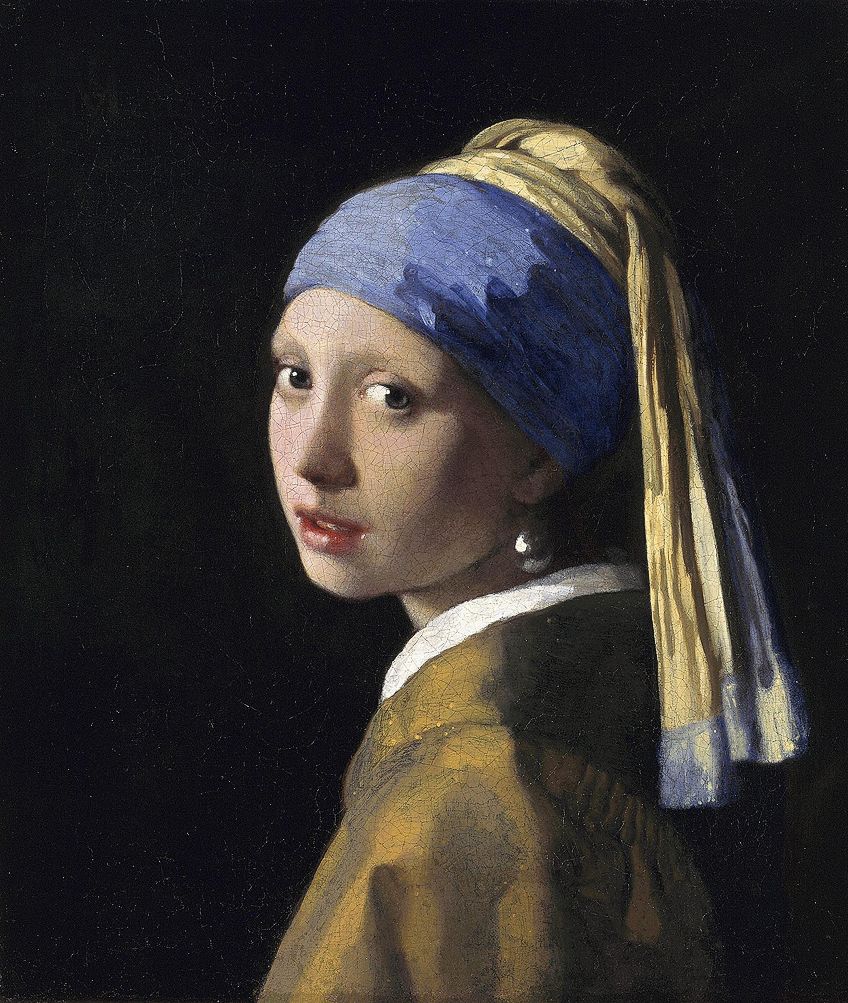
Girl With a Pearl Earring is one of the most famous oil-on-canvas paintings in the world and currently lies at the Mauritshuis Museum in The Hague. Johannes Vermeer received more recognition posthumously, which stands to highlight that no masterpiece is made in vain.
Vermeer also included the motif of the pearl in a few other paintings executed around the same time.
Napoleon Crossing the Alps (1801 – 1805) by Jacques-Louis David
| Artist | Jacques-Louis David (1748 – 1825) |
| Date | 1801 – 1805 |
| Medium | Oil on canvas |
| Dimensions (cm) | 260 x 221 |
| Where It Is Housed | Château de Malmaison, Rueil-Malmaison, France |
This iconic painting is also one of the most famous oil painting portraits of Napoleon Bonaparte captured on his horse by the French artist Jacques-Louis David. Jacques-Louis David was a prolific Neoclassical painter who excelled in the oil medium. He was also one of the primary figures of the French Revolution under the Jacobin party and close friends with Maximilien Robespierre.
In this painting, David renders Napoleon Bonaparte leading his troops through the Alps on his horse during the Spring of 1800.
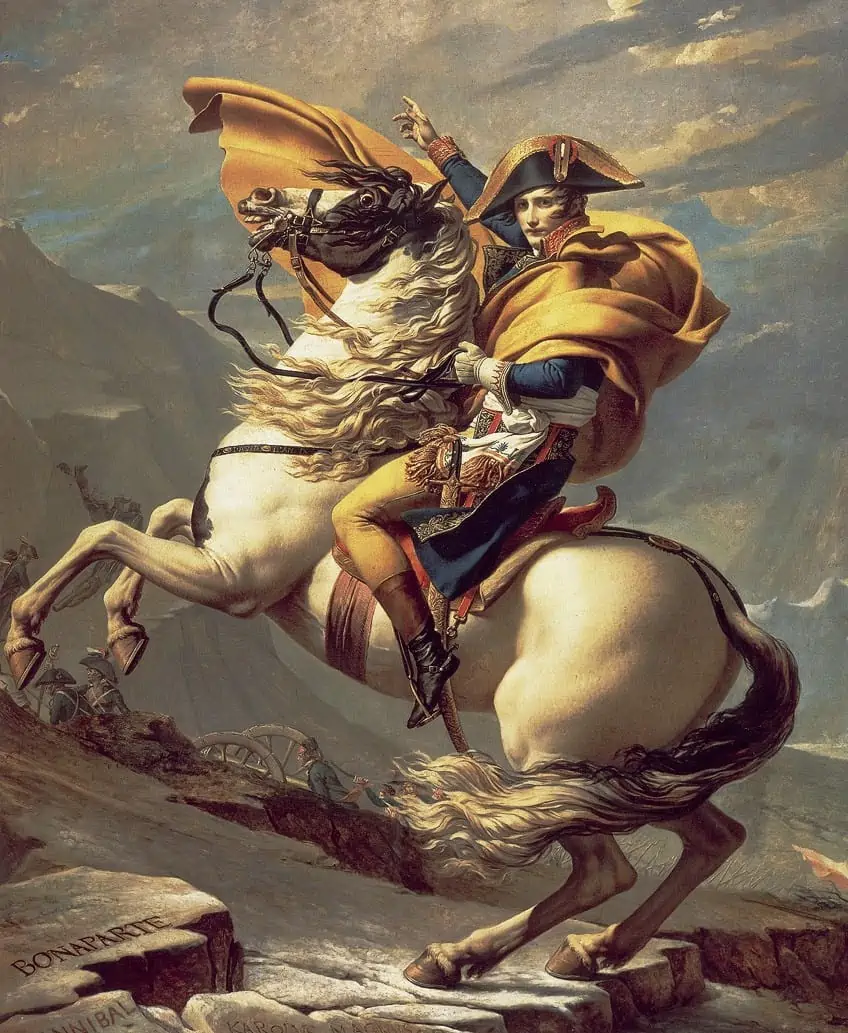
This scene took place in Napoleon’s attempt to attack the Austrian army in Italy and forms part of a series of paintings and was originally commissioned by the King of Spain. The painting represents an idealized depiction of the event and was not modeled by Napoleon himself. The painting was stationed in Spain until 1812 when Joseph Bonaparte took the painting to the United States with him after his abdication.
The painting was passed down to his descendants until it was bequeathed to the Château de Malmaison around 1949.
Whistler’s Mother (1871) by James Abbott McNeill Whistler
| Artist | James Abbott McNeil Whistler (1834 – 1903) |
| Date | 1871 |
| Medium | Oil on canvas |
| Dimensions (cm) | 144 x 162 |
| Where It Is Housed | Musée d’Orsay, Paris, France |
Whistler’s Mother by American artist James Abbott McNeil Whistler is one of the most famous oil paintings in the world for its iconic side-profile image of the artist’s mother, Anna McNeil Whistler. The painting is often described as the Victorian Mona Lisa and was allegedly created due to the story that the true model for the painting could not make the painting session for Whistler, hence, his mother was his model.
At some point, Whistler grew frustrated by the fact that people viewed his painting as a portrait or more importantly the identity of the sitter as expressed in his 1890 book, The Gentle Art of Making Enemies.
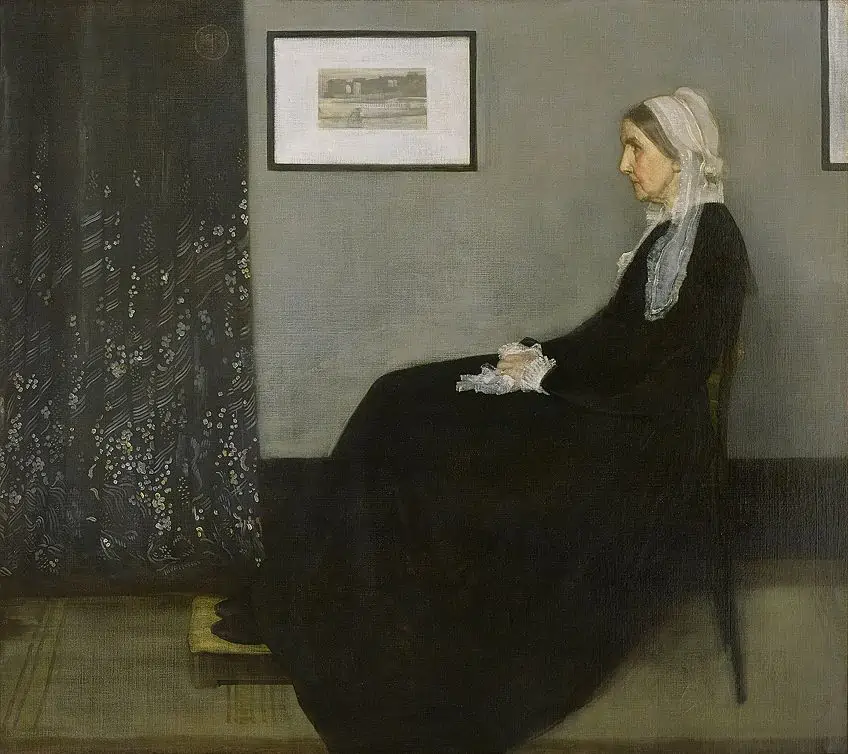
Whistler demonstrates his fine mastery over the colors black and gray while showcasing his adeptness at depth by creating a sharp contrast between his mother’s dark garments and the wall behind her. The atmosphere of the scene is still and calm, presented in an unforgettable manner that no other artist of his time had been able to successfully replicate.
Whistler’s Mother was also the subject of numerous popular culture productions, including The Rocky Horror Picture Show (1975), I Am Legend (2007), and Cloudy with a Chance of Meatballs 2 (2013).
Impression, Sunrise (1872) by Claude Monet
| Artist | Oscar-Claude Monet (1840 – 1926) |
| Date | 1872 |
| Medium | Oil on canvas |
| Dimensions (cm) | 48 x 63 |
| Where It Is Housed | Musée Marmottan Monet, Paris, France |
Created by the pioneer of French Impressionism, Claude Monet, this fine Impressionist oil painting on canvas was a showstopper in the late 19th century and remained one of the most recognized oil paintings of all time. The painting portrays a simple sunrise, yet this sunrise was executed in the classic Impressionist style defined by visible brush strokes and a lack of “complete detail”, which was shocking for art critics back in 19th-century Paris.
Monet was one of the founding leaders of the French Impressionist movement, which was a pivotal moment in art history, and went on to shape the approach and thinking behind oil painting and art in the broader context of Europe.
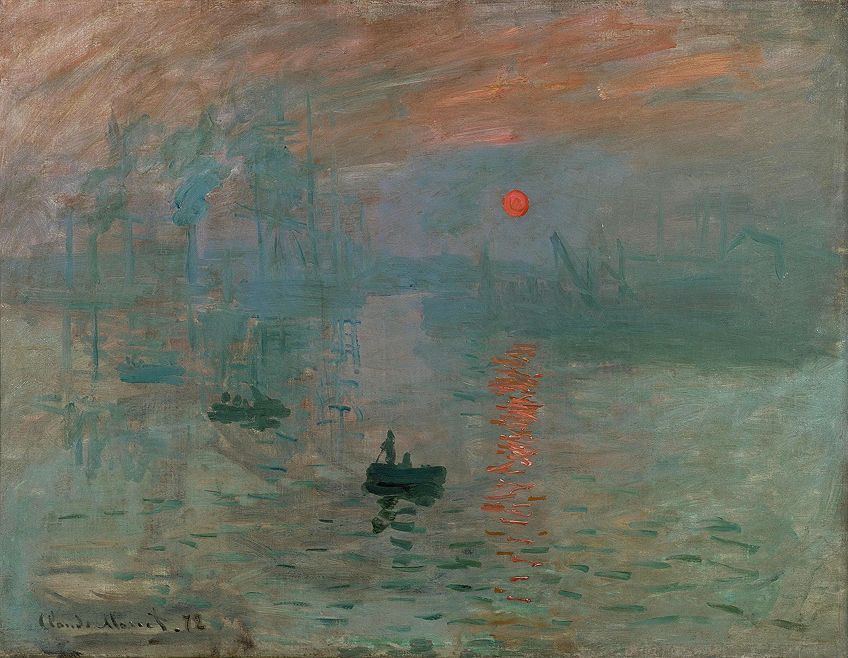
Impression, Soleil Levant, as the painting is known in French, showcases the sunrise at the port of Le Havre in Monet’s hometown. The painting is part of a series of six paintings that illustrate the port at different times of the day. Light and color were incredibly important to the fundamental style of Impressionist painting and as such, they influenced the visual aesthetic of Impression, Soleil Levant. The colors in the painting lack definitive boundaries and this is what makes the painting a masterpiece in its own right.
Impression, Sunrise is currently valued between $250 and $350 million.
The Starry Night (1889) by Vincent van Gogh
| Artist | Vincent Willem van Gogh (1853 – 1890) |
| Date | 1889 |
| Medium | Oil on canvas |
| Dimensions (cm) | 74 x 92 |
| Where It Is Housed | The Museum of Modern Art, Manhattan, New York, USA |
This is one post-Impressionist oil painting you will never get tired of. The Starry Night by Dutch artist Vincent van Gogh is one of the most memorable and vibrant oil paintings in art history that is not only admired for its beautiful brushwork and demonstration of the impasto technique but is also lauded for its creator’s dedication to pursuing a different visual aesthetic compared to other artists of his time.
Van Gogh’s life was chaotic in many ways yet his artwork speaks volumes in terms of his outlook on the future of art and the alternative approach to working with oil paint to evoke an imagined depiction of the landscapes before him.
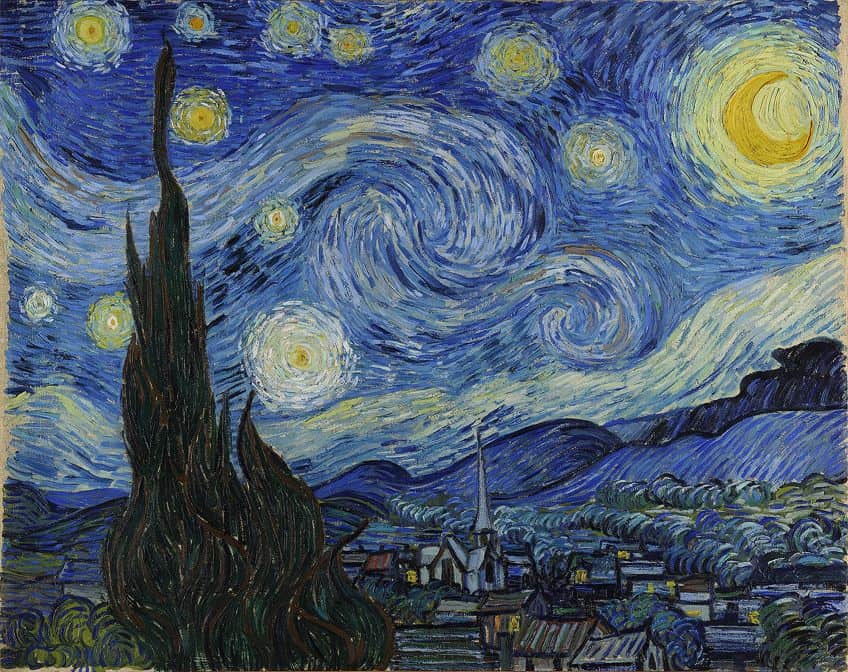
The Starry Night is a gorgeous flowing arrangement of blues and yellows layered in such a way that the image of Saint-Rémy-de-Provence is brought to life. The Starry Night is valued for being the only nocturne painting to depict a view of the area from Van Gogh’s bedroom window. The painting currently lies in the permanent collection of the Museum of Modern Art and remains one of the most recognized oil artworks by Vincent van Gogh to date.
The post-Impressionist oil painting is estimated to carry a value of around $100 million.
The Old Guitarist (1903 – 1904) by Pablo Picasso
| Artist | Pablo Ruiz Picasso (1881 – 1973) |
| Date | 1903 – 1904 |
| Medium | Oil on panel |
| Dimensions (cm) | 123 x 83 |
| Where It Is Housed | Art Institute of Chicago, Chicago, Illinois, USA |
A somber scene in the streets of Barcelona is captured by Pablo Picasso in his unique style during his “blue period”. The Old Guitarist is one of the most famous oil paintings in history for its eerie atmosphere evoked by the shades of blue that Picasso uses and the creepy, boney figure of an old man playing the guitar.
As depressing as this image may seem, it reflects the sincere sympathy that Picasso shared for the plight of the poor in Spain.
Picasso himself faced poverty and expressed his personal viewpoint by embedding his painting with such strong emotion. Experts arrived at an estimate on the value of Picasso’s The Old Guitarist, claiming that the painting may be worth well over $100 million.
The Kiss (1908 – 1909) by Gustav Klimt
| Artist | Gustav Klimt (1862 – 1918) |
| Date | 1908 – 1909 |
| Medium | Oil paint, gold leaf on canvas |
| Dimensions (cm) | 180 x 180 |
| Where It Is Housed | Belvedere, Vienna, Austria |
This romantic oil painting on canvas is one of the most cherished oil paintings in the whole of art history. The painting was created between 1908 and 1909 by Austrian artist Gustav Klimt and portrays a scene of a couple sharing an intimate kiss.
The Kiss is said to represent the Golden Epoch phase of Klimt where he employed an ornamental and decorative approach to painting informed by Byzantine mosaics and ancient Egyptian mythology.
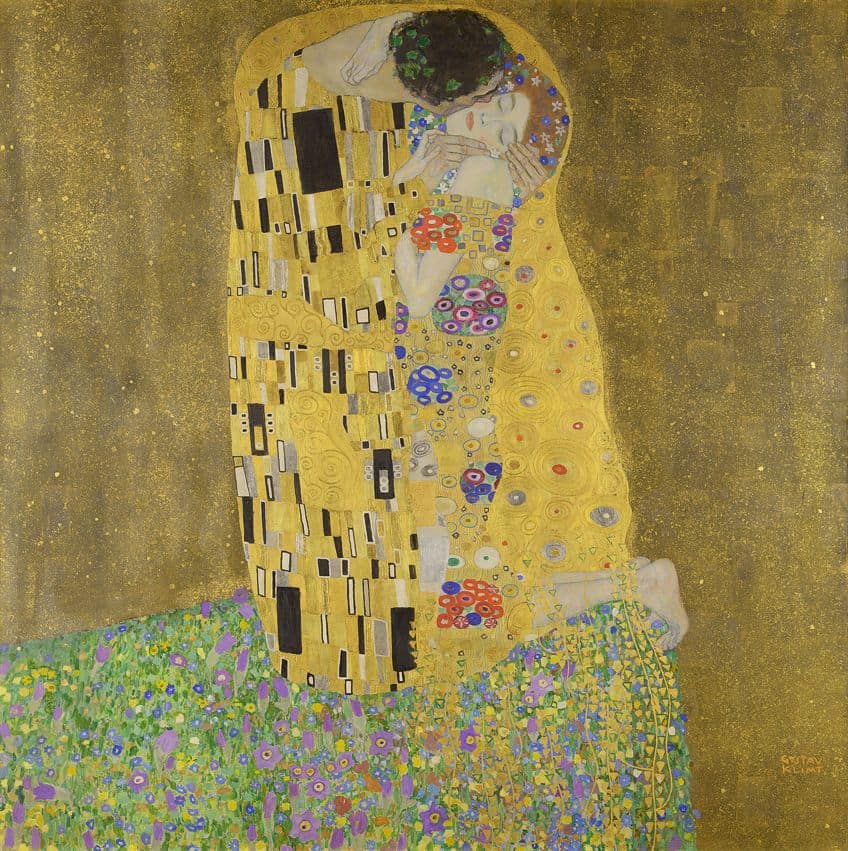
The romantic gesture is also symbolic of Klimt’s expression of love for Emilie Flöge, who was an Austrian fashion designer specializing in reform-styled, loose garments. Gustav Klimt was one of the leading members of the Austrian Secession movement and was most famous for his gold leaf-styled paintings since many of his earlier works were criticized as being overly pornographic and frank.
The Kiss stands at an estimated $240,000 with other Klimt paintings valued at well over $87 million.
American Gothic (1930) by Grant Wood
| Artist | Grant DeVolson Wood (1891 – 1942) |
| Date | 1930 |
| Medium | Oil on beaverboard |
| Dimensions (cm) | 74 x 62 |
| Where It Is Housed | School of the Art Institute of Chicago, Chicago, Illinois, USA |
American Gothic is one of the most popular oil paintings of the Regionalism genre in art, created in 1930 by Grant Wood. Grant Wood was one of the few artists who captured the rural American Midwest and American Gothic is considered his best work. Wood initially began his career in the military after World War I painting camouflage scenes. American Gothic portrays the image of a man and woman standing next to each other facing the viewer.
The woman’s gaze is cast to an unseen figure not seen in the frame but the man gazed directly at the viewer.
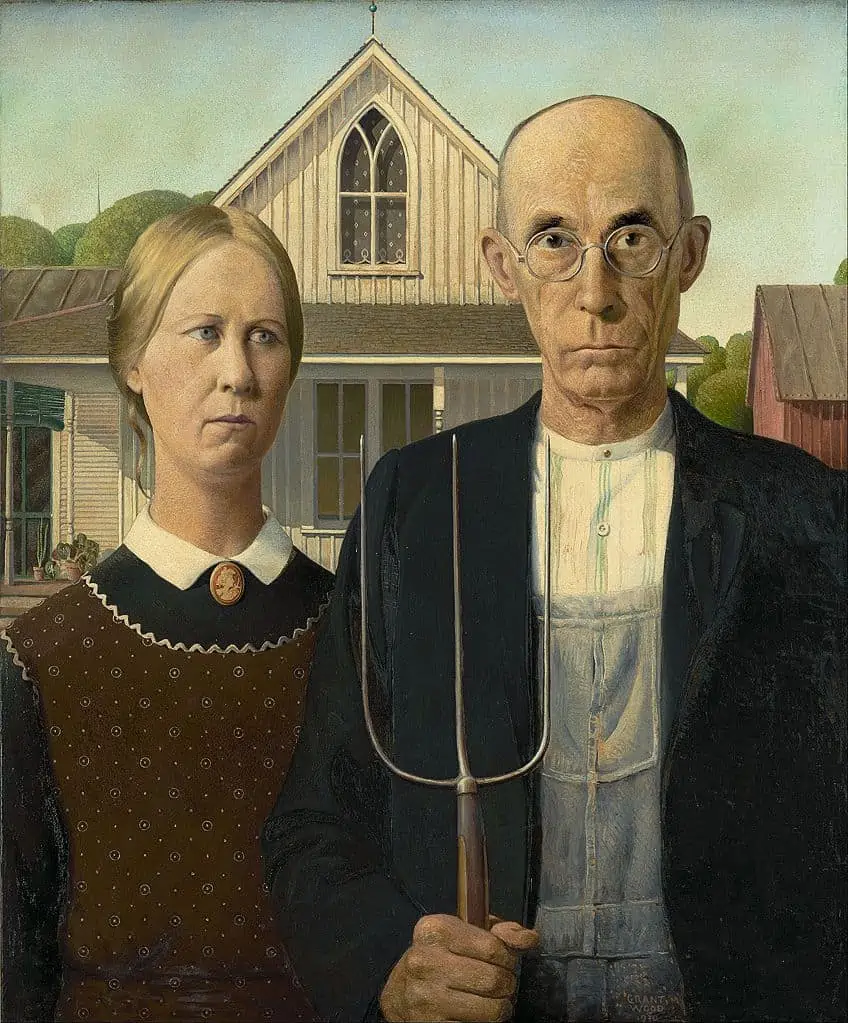
Upon the painting’s first exhibition at the Art Institute of Chicago, Wood walked away with instant recognition after winning a $300 prize. What inspired this famous oil portrait? A trip to Eldon in Iowa was what inspired Wood to paint American Gothic. It was in Eldon where he saw a Carpenter Gothic-style farmhouse.
Wood used his dentist and sister as the subjects of the imagined scene and dressed them as though they were “tintypes” from his family album.
The style of the painting was further informed by Flemish Renaissance art that Wood admired during his trips to Europe in the 1920s. American Gothic has since become a popular culture reference across the world and is commonly interpreted as a satirical comment on Midwestern characters.
The Persistence of Memory (1931) by Salvador Dalí
| Artist | Salvador Domingo Felipe Jacinto Dalí i Domènech, Marquess of Dalí of Púbol gcYC (1904 – 1989) |
| Date | 1931 |
| Medium | Oil on canvas |
| Dimensions (cm) | 24 x 33 |
| Where It Is Housed | The Museum of Modern Art, New York, USA |
The Persistence of Memory is one of the world’s most famous Surrealist oil paintings that showcases the dream-like representation of the world as seen through the eyes of Salvador Dalí. Dalí’s translation of the objects in this painting is something out of a fever dream. All solid objects appear to be soft and limp, which alters our knowledge of reality as most people perceive it. The metal draws in a horde of ants as if it is rotting flesh.
Dalí expertly painted an image that discredits reality while proposing another to evoke a sense of ridiculousness and confusion – an imagined reality.
Dalí still preserves some elements from actual reality by including cliffs in the distant background representing the coast of Catalonia, which was an iconic image from Dalí’s home. According to Dalí, the painting represents the “camembert of time” and thus all concepts of time must be lost.
The ants are symbolic of decay and a reminder of impermanence as they seem to attack the gold watch.
Dalí’s distorted face can also be seen in the painting as a fleshy structure with long eyelashes and a tongue oozing from the creature’s nose. The Persistence of Memory thus captures the essence of Surrealism and the unusual alien creature on the floor can be considered Dalí’s self-portrait.
Guernica (1937) by Pablo Picasso
| Artist | Pablo Ruiz Picasso (1881 – 1973) |
| Date | 1937 |
| Medium | Oil on canvas |
| Dimensions (cm) | 349 x 777 |
| Where It Is Housed | Museo Nacional Centro de Arte Reina Sofía, Madrid, Spain |
Guernica is a famous oil painting on canvas executed by Pablo Picasso in 1937. Guernica is a well-known painting made famous for its anti-war nature and monochromatic arrangement of the suffering and chaos echoed by the bombing of Guernica by Nazi Germany and Fascist Italy. The figures that stand out the most appear to be a screaming woman, a deceased infant, a dismembered body of a soldier, a flame, and a gored horse.
At the time of the incident, the majority of the male population of Guernica was at war and stationed far from home so the casualties were, sadly, mostly women and children.
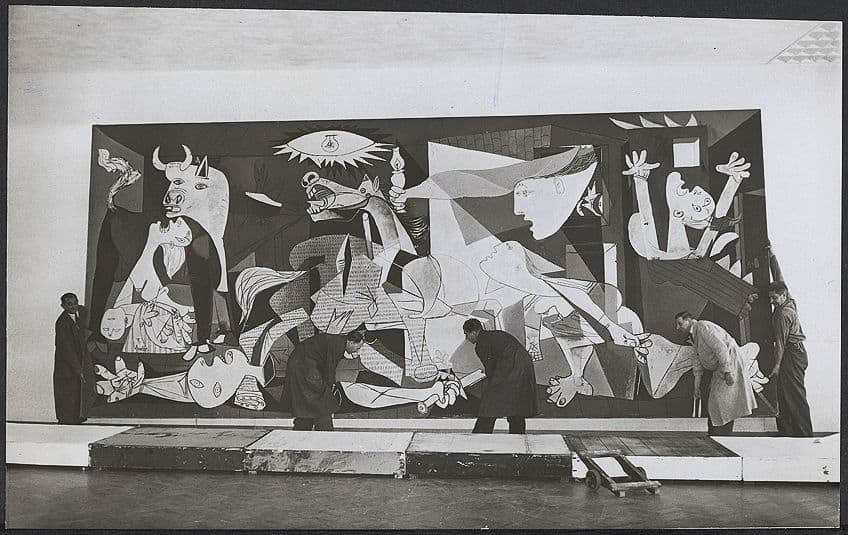
Guernica thus becomes an image of the aftermath of the horrific fight against the innocent and defenseless citizens of Guernica. The making of Guernica involved the use of matte-finish household paint that was created upon Picasso’s request to minimize the glossy effect as much as possible. Picasso received assistance from fellow American artist John Ferren in the preparation of the canvas.
Art historian John Richardson claims that photographer Dora Maar assisted Picasso with the monochromatic color of the painting such that it mimicked the black-and-white nature of photography.
Picasso was incredibly dedicated to the anti-Fascist cause and had the making of the Guernica documented in his studio for publicity and awareness toward anti-Fascism. Picasso commented on the making of the work, stating “I clearly express my abhorrence of the military caste which has sunk Spain in an ocean of pain and death”.
These incredible oil paintings have captured the hearts of many and live rent-free in the minds of many art lovers. Oil painting is not an easy art form and mastery takes practice. We hope that by studying these famous oil paintings, you can improve your practice and understanding of how one might apply the medium in different ways.
Take a look at our most famous oil paintings webstory here!
Frequently Asked Questions
What Is Oil Painting?
Oil painting is an artistic practice defined by the use of pigments mixed with drying oils as a binder and is one of the most common art forms for painting on panels or canvases.
Where Did Oil Painting Originate?
Oil painting originated in Afghanistan after it was discovered that a cave in Bamiyan contained a painting that was made using pigments mixed with oil. This corrected the belief that oil painting originated in Europe.
Who Are the Best Oil Painters in Art History?
The best oil painters in art history include artists such as Leonardo da Vinci, Salvador Dalí, Edvard Munch, Rembrandt van Rijn, Johannes Vermeer, Pablo Picasso, Vincent van Gogh, and many other prolific oil painters.
What Is the Most Beautiful Oil Painting in the World?
The most beautiful oil painting in the world is considered to be the Mona Lisa by Leonardo da Vinci, which is an oil-on-panel painting created around 1503 and is currently housed at the Musée du Louvre in Paris.
Liam Davis is an experienced art historian with demonstrated experience in the industry. After graduating from the Academy of Art History with a bachelor’s degree, Liam worked for many years as a copywriter for various art magazines and online art galleries. He also worked as an art curator for an art gallery in Illinois before working now as editor-in-chief for artfilemagazine.com. Liam’s passion is, aside from sculptures from the Roman and Greek periods, cave paintings, and neolithic art.
Learn more about Liam Davis and about us.
Cite this Article
Liam, Davis, “Famous Oil Paintings – The Top Oil Artworks Ever Made.” artfilemagazine – Your Online Art Source. December 14, 2022. URL: https://artfilemagazine.com/famous-oil-paintings/
Davis, L. (2022, 14 December). Famous Oil Paintings – The Top Oil Artworks Ever Made. artfilemagazine – Your Online Art Source. https://artfilemagazine.com/famous-oil-paintings/
Davis, Liam. “Famous Oil Paintings – The Top Oil Artworks Ever Made.” artfilemagazine – Your Online Art Source, December 14, 2022. https://artfilemagazine.com/famous-oil-paintings/.



